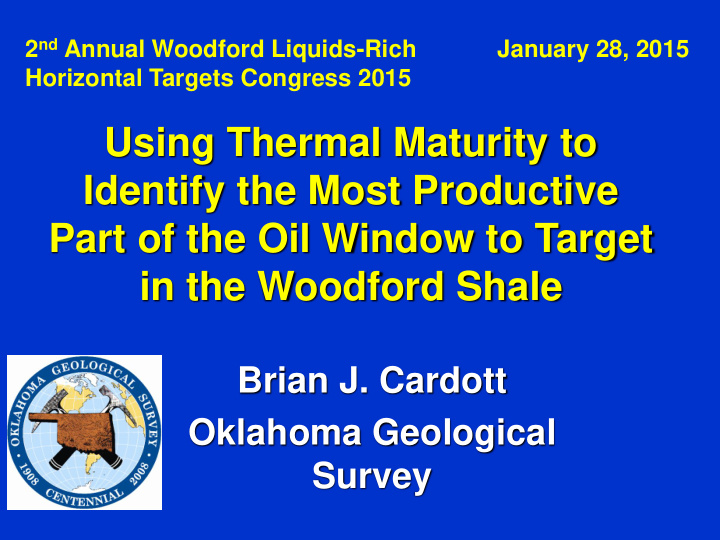



2 nd Annual Woodford Liquids-Rich January 28, 2015 Horizontal Targets Congress 2015 Using Thermal Maturity to Identify the Most Productive Part of the Oil Window to Target in the Woodford Shale Brian J. Cardott Oklahoma Geological Survey
Outline of Presentation Define the Oil Window Evaluate Woodford Shale (Late Devonian- Early Mississippian) well completion maps based on thermal maturity and production rates.
What is the most productive part of the oil window for tight oil in shale? PEAK OIL GENERATION (peak rate) PEAK WET GAS GENERATION PEAK DRY GAS GENERATION OIL FLOOR WET GAS FLOOR Modified from Dow (1977), Houseknecht DRY GAS GENERATION LIMIT and Hathon (1987), and Taylor and others (1998) DRY GAS PRESERVATION LIMIT
Most petroleum geochemists use 0.6% Ro as the onset of oil generation (e.g., Peters and Cassa, 1994, Applied source rock geochemistry: AAPG Memoir 60, p. 93-117)
Jarvie (2012, p. 91): “…thermal maturity values from about 0.60 to 1.40% Ro are the most likely values significant for petroleum liquid generation. Regardless of thermal maturity, there must be sufficient oil saturation to allow the possibility of commercial production of oil ”.
Jarvie (2012, p. 91): “Although an organic-rich source rock in the oil window with good oil saturation is the most likely place to have oil, it is also the most difficult to produce, unless it has open fractures or an organic-lean facies closely associated with it.”
Oil production from the Woodford Shale is dependent on the development of natural fractures from the brittle biogenic-silica- rich shale “There is simply no way to access the hydrocarbons locked in the shale matrix unless there is a system of stable natural fractures and fissures connected to the wellbore.” from G.E. King (2014)
Guidelines for the Barnett Shale VRo Values Maturity <0.55% Immature 0.55-1.15% Oil Window (peak oil at 0.90%VRo) 1.15-1.40% Condensate – Wet- Gas Window >1.40% Dry-Gas Window From Jarvie and others, 2005
Consider: Much of the generated oil does not migrate out of the rock. Meyer (2012, p. 72) indicated that “for every barrel of crude oil in conventional reservoirs…there are 8 bbl of potentially producible oil equivalents remaining in the source rock” and “Speculative estimates of just how much generated oil remains in shale source rocks range between 45% and 95% depending on the geology of the formation and the quality of the estimate.”
Consider: Saturation, beginning at ~0.6% VRo, suggests beginning of oil migration. Peak oil generation is at ~0.90% VRo. Migration pathways within shale (e.g., microfractures) are required for oil migration and storage. Condensate behaves as a gas in the reservoir. Barring oil migration, the best thermal maturity for tight oil production is peak to late mature (0.7-1.2% VRo) in a naturally-fractured reservoir.
Woodford Shale Well History 3,515 Woodford Wells, 2004 – 2014 534 467 497 [Post 2008 emphasis on liquid hydrocarbon production due to low price of natural gas]
Oklahoma Geologic Provinces Geologic provinces from Northcutt and Campbell, 1995
Oklahoma Gas/Tight Oil Shales (3,727 well completions, 1939-2014)
Woodford Shale Wells (2004-2014) Most Woodford “oil wells” (based on GOR <17,000) 3,511 Woodford wells have low IP gas.
Woodford Shale (2011-2014) [424] [435] Cana [467] [497] SCOOP Emphasis on liquid hydrocarbons
Anadarko Basin 0.67% 0.77% 0.55% GF 0.49% GF 0.77% Woodford Shale Isoreflectance Map based on 81 wells (Cardott, 1989)
Woodford Shale Anadarko Basin IP Oil
Woodford Anadarko Basin API Gravity
Woodford Shale Vitrinite Reflectance Data in Southern Oklahoma (Updated October 2013) Southern Oklahoma Woodford Shale vitrinite reflectance map based on 51 locations Cardott, in preparation
Woodford Shale Ardmore Basin IP Oil
Isoreflectance Map of the Woodford Shale in Eastern Oklahoma (Updated November 2011) Distribution of 1.06% 117 Woodford 0.90% Thermal Shale samples Anomaly with vitrinite- 0.77% reflectance data (n ≥20; whole-rock pellets) Cardott, in preparation
Woodford Shale Central OK IP Oil Most wells have a liner; Mississippian Ls above 0.50-0.77% Ro
Conclusions Lower oil production rates occur at <0.60% Ro (dependent on oil saturation). Oil production ranges from thermal maturities of ~0.59-1.18% Ro in the Anadarko, Ardmore, and Arkoma Basins and shelf areas (dependent on oil saturation). Higher initial production rates and higher cumulative production occurs at higher thermal maturities. Condensate production ranges from thermal maturities of ~1.15-1.67% Ro in the Anadarko, Ardmore, and Arkoma Basins.
Recommend
More recommend